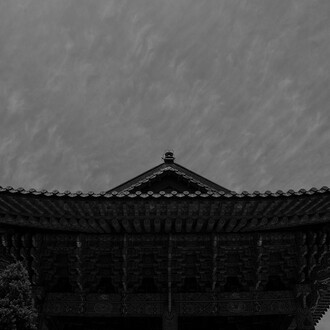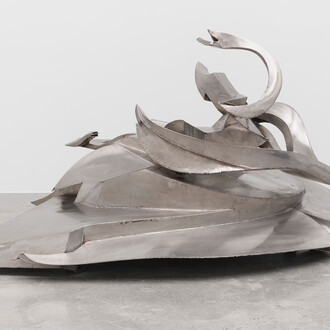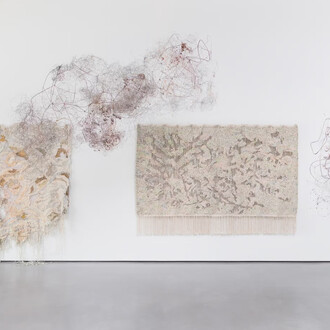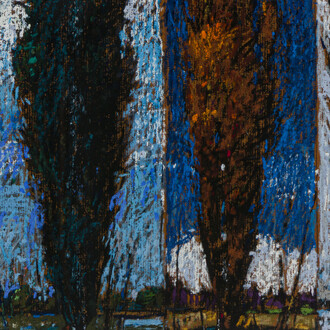Aicon is pleased to announce the debut exhibition of Kelly Sinnapah Mary at the gallery, her first solo presentation in the United States. The eponymous show features new paintings and sculptures and is curated by her frequent collaborator, Andil Gosine.
Since 2015, Sinnapah Mary has developed a body of work that can be described as a visual notebook in which she grapples with the discovery of her ancestral origins and the questions and contentions it unfurls, including about her relationships to plant and animal life. As a child in Guadeloupe, Sinnapah Mary understood herself to be Afro-Caribbean. As an adult, she began to unpack her actual roots, as a descendant of Tamil indentured workers brought to the Caribbean in the mid-nineteenth century to replace enslaved people after abolition.
Borrowing the title from Aimé Césaire’s epic poem, Notebook of a Return to the Native Land, with a slight but significant modification, the artist highlights the impossibility of returning to a distant and idealized ancestral home as someone with a creolized Indian identity.
A central figure in many of Sinnapah Mary’s works is the schoolgirl, Sanbras, a figure that has become a foil for the well-known title character in the 1899 children’s book The Story of Little Black Sambo. According to Gosine, “Through the re-presentation of iconic scenes from the text as tattoos, Sinnapah Mary both acknowledges the enduring influence of these racist tropes and pushes against them through her own reinventions. In Sinnapah Mary’s hands, for example, Sambo’s enemy tiger becomes an ally for her schoolgirl icon, Sanbras.”
The role of literature in Sinnapah Mary’s works is not limited to children’s books and fairy tales. In one work, Charles Darwin’s On the Origin of Species—a book whose theories spurred the scientific demarcation of man from animal—rests on a kitchen table before a framed portrait of a human-animal hybrid Sanbras. As Gosine explores in his book Nature’s Wild, the project of colonization relied on the classification of certain peoples as less-than-human to secure power.
In her painting, Sinnapah Mary rejects the colonial impulse to define humans as not-animal and instead blurs the line between the two. She highlighted her desire to reconfigure the human-animal dichotomy during a conversation with the curator in which she recalled an encounter at a zoo: “I found myself in front of a glass cage where orangutans locked up. I observed them and they observed us. I felt as though I could read their thoughts: ‘Let’s reverse our places, you are not superior to us…’ I was so uncomfortable in front of them while the other spectators were having fun.”
In another painting depicting a nude Venus-like figure stretched out on a white embroidered blanket in a forest, the artist channels the unapologetic sexuality of Maryse Condé’s fictionalization of Tituba, a slave from Barbados who was among the first to be accused of witchcraft in Salem. There is a parallel between Tituba’s quest to return to her native land and Sinnapah Mary’s visual notebook. In her foreword for the novel, Angela Y. Davis offers the following analysis, which can be used to interpret Sinnapah Mary’s body of work:
Tituba’s revenge consists in reminding us all that the doors to our suppressed cultural histories are still ajar. If we are courageous enough to peer through the narrow openings, we will discover our fears, our rage, our hopes, and our roots. And sometimes there is magic behind those doors, sparkling clues about the possibilities ahead.
(Angela Y. Davis, foreword to I, Tituba, Black Witch of Salem, Maryse Condé translated by Richard Philcox (Charlottesville, VA: University of Virginia Press, 2009) p. xiii)
Throughout her exhibition, Sinnapah Mary challenges the viewer to look deeper with her mix of motifs culled from Hinduism, Christianity, literature, and the artist’s own life. Symbols are combined to form intricately patterned tattoos that creep along the skin of her figures like vines. Lush landscapes teeming with tropical plants and animals, both native and invasive to Guadeloupe, slowly reveal their hidden depths. Even the carefree and innocent sculptures turn sinister upon closer inspection with severed limbs and scrawls of profanity. Sinnapah Mary’s exhibition introduces gallery visitors to a powerful voice in Indian diasporic art through painting, sculpture, tapestry, and sound, making for a sparkling premiere of the artist’s work.













